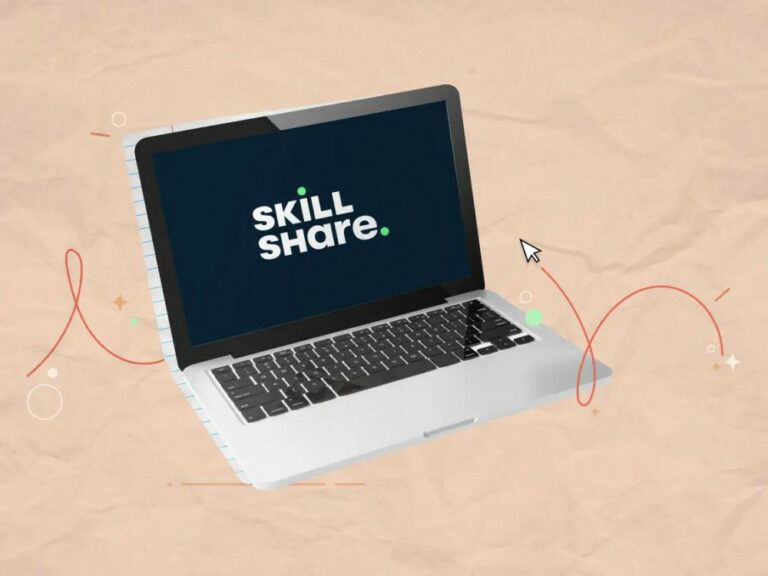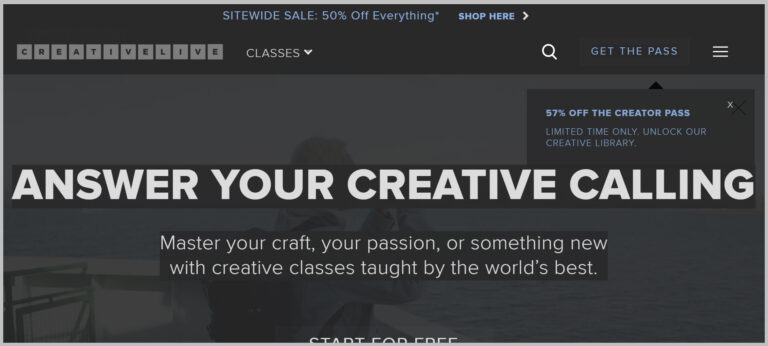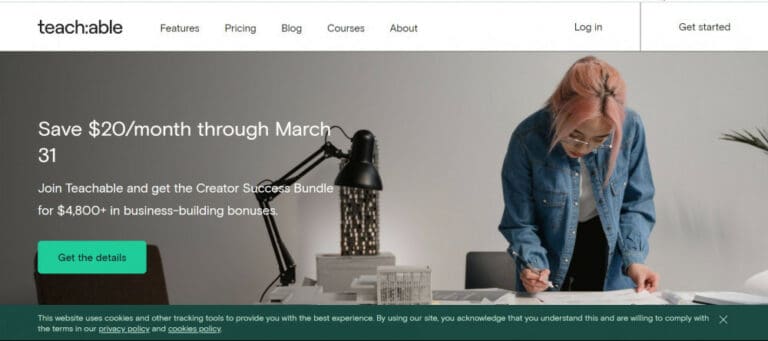How To Sell An Online Course
Selling an online course is one of the most rewarding ways to share knowledge and earn income. With more learners turning to digital platforms, now is the perfect time to launch your course.
This article will show you how to sell an online course successfully, from design and creation to marketing and sales success, regardless of whether you're teaching a professional subject, a hobby, or a skill.
Most Profitable Niches For Online Courses
Here are some of the most profitable niches for online courses based on demand, low overhead, and high-value skills:
1. Technology And Programming
Tech courses remain top-earning due to the demand for digital skills. Python programming, data science, machine learning, full-stack web development, app development, and ethical hacking are frequently covered in these courses.
Advanced learners also seek cloud computing (AWS, Azure), DevOps, and blockchain. Annual earnings range from $5,000 to over $100,000+.
Case Study
Colt Steele earned over $1M teaching web development bootcamps with project-based learning on Udemy.
2. Digital Marketing
Digital marketing courses teach individuals and business owners how to grow online. They include SEO, social media advertising (Facebook, Instagram, TikTok), Google Ads, email marketing, funnel building, affiliate marketing, and analytics tools like Google Analytics. These practical skills lead to freelance work or job promotions. Top creators earn $10,000–$500,000+ annually.
Case Study
Sorav Jain built a 7-figure income stream teaching digital marketing across platforms and his academy.
3. Finance And Investing
Finance courses empower learners to manage or grow money. Popular topics include budgeting, saving, credit repair, stock market investing, crypto, retirement planning, real estate investing, and financial independence. These courses appeal to students, professionals, and retirees alike. Creators can earn $20,000 to $200,000+.
Case Study
“The Budgetnista” Tiffany Aliche earned over $1M helping women understand budgeting and credit through her “Live Richer Academy.”
4. Health And Wellness
Health and wellness courses address physical and mental well-being. Topics include weight loss, meal planning, plant-based nutrition, yoga routines, home workouts, meditation, stress relief, and holistic healing (e.g., Ayurveda or essential oils). As wellness is emotionally driven, students are highly motivated. Annual earnings can hit $250,000+.
Case Study
Yoga With Adriene turned free YouTube videos into a premium membership site, earning millions.
5. Career Development And Soft Skills
These courses help professionals excel in the workplace. They typically include leadership, time management, emotional intelligence, team communication, public speaking, productivity tools (e.g., Notion, Trello), and negotiation. Organizations often buy them for teams. Earnings can exceed $300,000.
Case Study
Vanessa Van Edwards built Science of People, selling soft-skill courses featured on platforms like LinkedIn Learning and used by top firms.
6. Entrepreneurship And Business
Business-focused courses are perfect for aspiring founders and freelancers. Topics often include how to start a business, product validation, branding, digital product creation, eCommerce (Shopify, dropshipping), marketing strategies, and scaling. Courses priced at a premium can earn $20,000–$500,000+.
Case Study
Foundr scaled into an 8-figure business offering entrepreneurial courses with top-tier guest instructors like Richard Branson and Sara Blakely.
7. Creative Skills
Courses in this niche teach people how to turn passion into income. Topics include photography (portrait, product, drone), graphic design (Adobe Illustrator, Canva), video editing (Final Cut Pro, Premiere), music production, creative writing, and painting. Creators earn $1,000–$50,000+ via platforms like Skillshare or self-hosted sites.
Case Study
Aaron Draplin, a graphic designer, earned over $100,000 from one Skillshare course on logo design.
8. Language Learning
Language courses cater to travellers, expats, and job seekers. Top topics include English as a second language, Spanish, Mandarin, French, and business English.
Courses often include grammar, pronunciation, speaking practice, and cultural context. Creators can earn $5,000 to $150,000+ annually.
Case Study
Olly Richards grew I Will Teach You A Language into a 7-figure business with story-based language courses and audiobooks.
9. Test Preparation
High-stakes exams drive students to purchase prep courses. Topics include SAT/ACT for college admission, IELTS/TOEFL for language certification, GRE/GMAT for graduate programs, and LSAT/MCAT for law and medical school.
Courses often include practice questions, timed tests, strategy tips, and video explanations. Instructors can earn $20,000–$300,000+.
Case Study
Magoosh, now a multimillion-dollar company, sells test prep for nearly every major standardized exam.
10. Personal Development
This niche appeals to those seeking transformation and fulfillment. Courses often cover confidence-building, goal setting, habit formation, mindfulness, journalling, emotional healing, and brain rewiring techniques. With compelling storytelling and impact, creators can earn $5,000 to $250,000+.
Case Study
Mindvalley grew into an 8-figure empire offering courses on spiritual growth, peak performance, and self-awareness to a global audience.
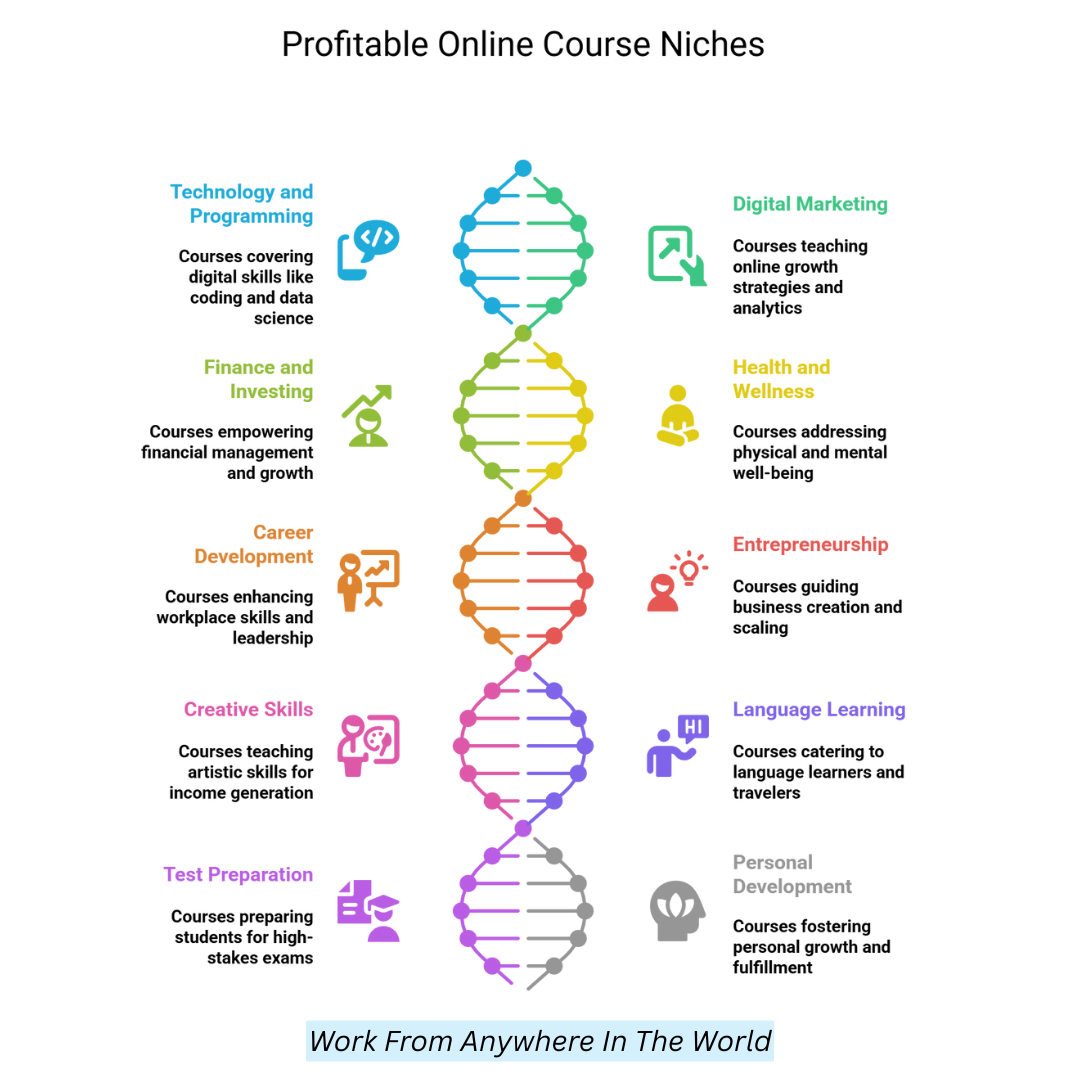
Steps To Sell An Online Course
1. Identify Your Niche and Audience
Before creating your course, identify the niche where your expertise lies and determine your ideal students. Start by listing your skills and areas of profound knowledge. Use tools like Google Trends, Reddit, and Quora to discover popular questions and unmet needs in those fields.
Make a profile of your ideal student that includes their age, occupation, and obstacles they have faced. This makes your messaging and content more suited.
For example, instead of offering a generic photography course, narrow your focus to something specific like “iPhone Photography for Beginners.” A clear, focused niche makes your marketing more precise and effective.
Key Points
- Define your expertise and interests.
- Use tools like Google Trends, Reddit, and Quora.
- Build a profile of your ideal student
- Target a specific sub-niche
2. Validate Your Course Idea
Avoid wasting time on a course nobody wants by validating the idea before you build. Start by conducting surveys through platforms like Google Forms and distributing them across social media, newsletters, and relevant communities. Run a free live workshop or webinar covering your intended course topic to gauge interest and collect feedback.
Create a simple landing page using Carrd or MailerLite with course details and an email opt-in form: track signups and engagement metrics. If you see promising traction, even a few pre-orders, it’s a good indication your course idea has real demand.
Key Points
- Survey your audience with tools like Google Forms
- Offer free live workshops or webinars
- Build a landing page with the course description
- Track interest and pre-orders
3. Plan And Outline Your Course
Content Structure is key to creating a valuable learning experience. Start with a complete course outline, breaking it into 4–8 core modules.
Under each module, define 3–5 specific lessons or outcomes. Decide on your delivery formats—videos, slideshows, PDFs, quizzes, or a mix. Use Trello, Notion, or Google Docs to organize everything.
Establish learning goals for each section to keep content focused. This planning phase ensures you don’t miss essential topics, streamlines production, and helps students follow a logical path from beginning to end, increasing the course's effectiveness.
Key Points
- Break down into 4–8 main modules.
- Use Trello, Notion, or Google Docs for organization.
- Define goals for each lesson
- Choose formats: video, PDF, quizzes, etc.
4. Create High-Quality Course Content
Production quality impacts student engagement and satisfaction. Invest in a decent microphone like the Blue Yeti and use voice recording tools like Loom, OBS Studio, or ScreenFlow.
Write scripts or outlines for your videos to stay on message—record in a quiet, well-lit area with minimal distractions. Edit your videos using software like iMovie or Camtasia, cutting out errors and adding smooth transitions.
Include captions and graphics to support different learning styles. Providing clean, explicit, and well-edited content will establish professionalism and make your course more valuable and enjoyable for students.
Key Points
- Use quality equipment (Blue Yeti, OBS Studio)
- Write scripts or outlines for each video
- Record in quiet, well-lit environments
- Add captions and visual aids
5. Choose The Right Platform To Host Your Course
Your course needs a solid delivery platform. Hosted platforms like Teachable, Thinkific, and Podia provide easy-to-use interfaces with built-in tools for student management, payment processing, and email marketing.
For more customization, use WordPress with LearnDash or LifterLMS plugins. Listing your course on online marketplaces such as Udemy is another option, but remember that these platforms set prices and keep a portion of the sales.
Evaluate your technical comfort level, the size of your audience, and long-term goals before choosing. Your platform choice affects the learning experience, your income potential, and how much control you maintain.
Key Points
- Evaluate hosted platforms (Teachable, Podia)
- Consider WordPress + LMS plugins
- Review your control, pricing, and audience
- Understand platform fees and revenue share

6. Price Your Course Strategically
Pricing should reflect the transformation your course offers. Analyze competitor pricing to understand market expectations.
For in-depth, skills-based courses, prices between $100 and $500 are typical. Entry-level or introductory courses might be priced from $25 to $75.
Consider tiered pricing to appeal to a broader audience: a basic version, a mid-tier with bonus content, and a premium VIP package with coaching.
Use early-bird discounts or special launch offers to drive initial signups. Always highlight the value and outcomes students can expect, not just the course length or materials, to justify your pricing and boost conversions.
Key Points
- Study competitors' pricing structures
- Offer tiered pricing: introductory to VIP
- Justify pricing with value delivered
- Use discounts for early sign-ups
7. Build A Sales Funnel
A sales funnel nurtures prospects from awareness to enrollment. Attract leads with top-of-funnel content like blogs, free guides, or videos. In return for email signups, provide a lead magnet, such as a checklist or mini-course.
Then automate a welcome email sequence using tools like ConvertKit or Mailchimp, educating subscribers on your expertise and showcasing the course’s benefits.
Conclude with a compelling call-to-action, such as limited-time discounts or early access. An effective sales funnel builds trust, keeps your audience engaged, and increases your chances of converting leads into paying students.
Key Points
- Start with free content and lead magnets
- Automate email sequences (ConvertKit, Mailchimp)
- Build trust and highlight course benefits
- End with a compelling call-to-action
8. Promote Your Course
Consistent promotion is essential for course success. Use content marketing—blogs, YouTube videos, social posts—to share tips related to your course topic.
Create an email list and send reminders and valuable content in your newsletters. Run targeted Facebook or Google ads to reach your audience.
Collaborate with influencers or experts for shoutouts or joint webinars. Create an affiliate program to incentivize others to sell your course.
Post testimonials and case studies to build credibility. Keep promoting after launch through evergreen content and retargeting ads to attract new students and boost sales continually.
Key Points
- Use content marketing, social media, and email
- Run ads on Facebook or Google
- Partner with influencers and affiliates
- Share testimonials and success stories
9. Engage And Support Your Students
Student satisfaction drives retention and referrals. Send weekly emails with reminders, tips, and encouragement. Offer live office hours or monthly Q&A sessions to foster real-time connection.
Create a private group on Facebook or Discord for peer interaction and networking. Respond quickly to student questions and support requests.
Gamify learning with progress badges or certificates to boost motivation. Active engagement keeps students progressing through the course, increases completion rates, and improves reviews. A supportive instructor presence is among the strongest differentiators in a crowded e-learning marketplace.
Key Points
- Send weekly support and encouragement emails.
- Host live Q&A or office hours
- Create community groups (Facebook, Discord)
- Use gamification and respond quickly
10. Collect Feedback And Improve
Ask for student feedback after each module through quick surveys via Google Forms or Typeform. Monitor course analytics to see where students drop off or struggle.
Use quizzes and engagement stats to assess knowledge retention. Revise or expand underperforming sections based on feedback.
Add supplemental resources, transcripts, or walkthrough videos if needed. Relaunch your course with improved content and market it as a new version (e.g., “Course 2.0”).
Showing you listen and act on student input enhances credibility, boosts word-of-mouth marketing, and can significantly increase long-term enrollments.
Key Points
- Use surveys after each module.
- Monitor analytics for drop-off points.
- Improve weak lessons and add resources.
- Relaunch the updated course as version 2.0
11. Scale Your Course Business
Once your first course is proven, scale strategically, create follow-up or advanced courses for your existing students, and bundle related courses into a discounted package.
Launch a membership site offering access to all your content. Offer live workshops, coaching, or group sessions for higher-ticket revenue.
License your course to schools or companies for bulk use. Use evergreen webinars and automated email sequences to keep sales flowing.
Continuously update your content and grow your email list. As you scale, reinvest profits into better tools, content, and marketing to build a sustainable course business.
Key Points
- Create advanced or follow-up courses.
- Package and bundle content
- Offer memberships, coaching, and licensing
- Automate marketing and reinvest in growth
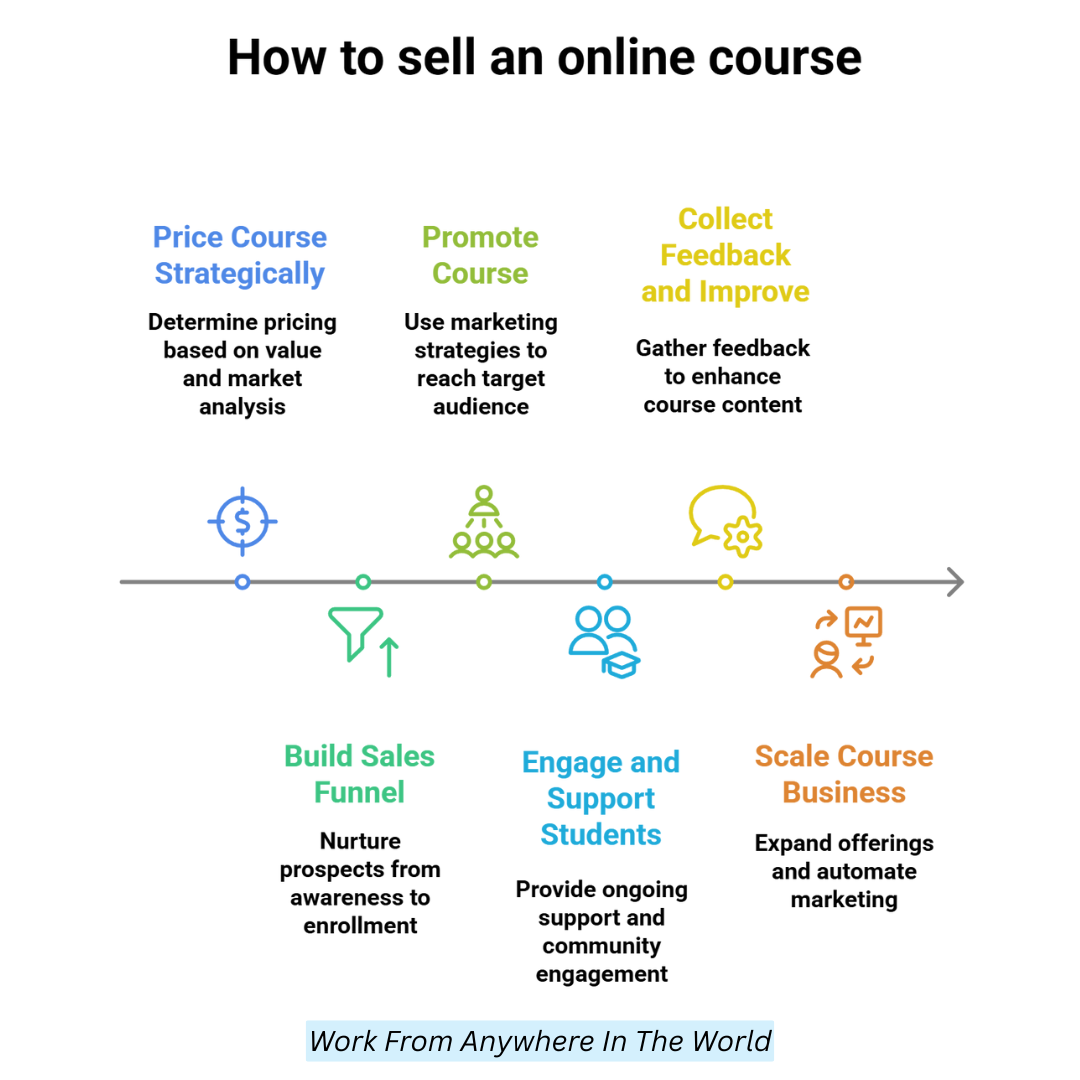
Top Platforms For Developing And Marketing Online Courses
The top platforms for developing and marketing online courses in 2025 are listed below, ranked by features, cost, and usability:
1. Teachable
Teachable is ideal for beginners wanting to create polished courses without tech skills. It offers a drag-and-drop builder, marketing tools, and upsells. The platform is easy to use, though the free plan includes transaction fees. Paid plans start at $39/month.
2. Thinkific
Thinkific is perfect for entrepreneurs and coaches looking for a scalable platform. It allows course customization, quizzes, and drip scheduling.
There are no transaction fees, even on the free plan. Paid options begin at $49/month, making it a substantial value for serious creators.
3. Kajabi
Kajabi is a robust all-in-one platform offering websites, email, sales funnels, and course hosting. It's designed for professionals who want complete control.
Though powerful, it's more expensive, starting at $149/month. Ideal for established businesses needing comprehensive tools in one place.
4. Podia
Podia is simple yet versatile, great for selling courses, downloads, and webinars. It supports memberships and community features, all with a clean user interface. There's a free plan with an 8% transaction fee, while paid plans start at $39/month without additional costs.
5. Udemy
Udemy gives course creators instant access to a vast global audience. You don’t need to handle marketing or tech setup.
However, pricing and promotions are controlled by Udemy, and you’ll typically share 50% of course revenue with the platform.
Wealthy Affiliate – Mini Review (2025)
If you’ve ever thought about turning your blog, passion, or niche into an online business,
Wealthy Affiliate (WA) is one of the most beginner-friendly platforms I’ve used.
It combines step-by-step training, website hosting, SEO research tools,
and an active community all in one place.
What I like most: you can start free (no credit card needed),
explore lessons, test the tools, and connect with other entrepreneurs
before upgrading. WA isn’t a “get rich quick” scheme — it’s a platform where success comes
from consistent effort and applying what you learn.
6. Skillshare
Skillshare is best for creatives focusing on art, design, and writing. Instead of direct sales, you earn royalties based on watch time.
You must apply to teach, and payments depend on student engagement and referrals. It’s excellent for building passive income streams.
7. LearnWorlds
LearnWorlds caters to professionals needing interactive learning tools. It includes quizzes, certifications, and SCORM support.
This highly customizable platform supports white labelling, making it ideal for institutions. Plans start at $29/month but require more setup time than simpler platforms.
8. Gumroad
Gumroad is excellent for selling mini-courses, ebooks, or digital downloads quickly. It's easy to use and doesn’t require a full course site.
There’s a 10% transaction fee, but no upfront cost, making it perfect for creators testing the market or offering low-cost products.
9. Systeme.io
Systeme.io is a budget-friendly all-in-one solution with tools for course creation, sales funnels, email marketing, and blogging.
It’s simple to use and great for solopreneurs. The free plan includes generous features, and paid plans begin at just $27/month, offering great value.
10. Coursera (Partner Model)
Coursera partners with universities and institutions to deliver accredited online courses. It’s not open to individual creators but offers enormous exposure for organizations.
Partner content appears alongside top universities. Earnings are shared, and setup requires an institutional affiliation or academic credibility.
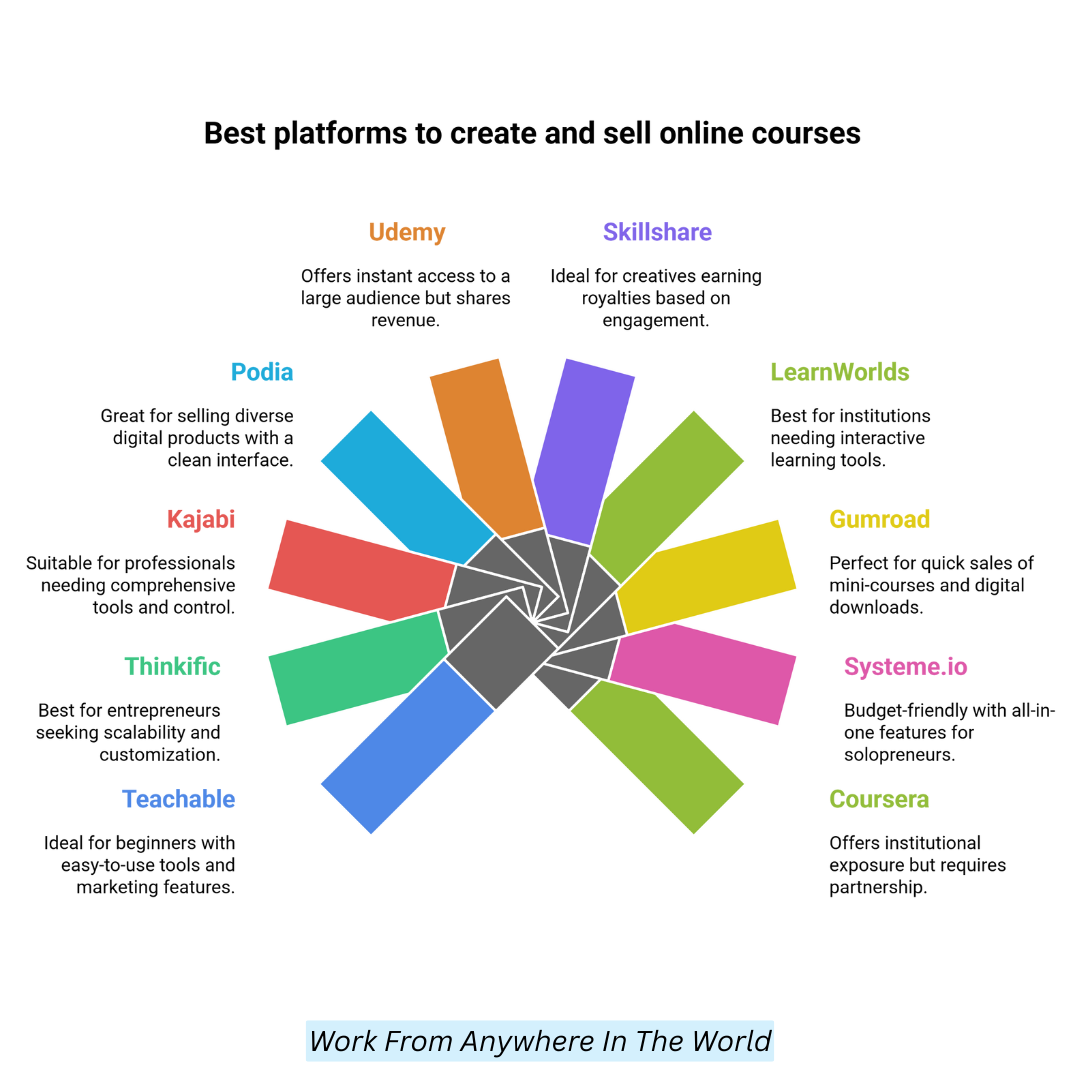
Conclusion
Selling online courses is a great way to earn a steady income and share knowledge. Applying the right marketing strategies and delivering real value can attract eager learners and build a loyal community.
Remember, success doesn’t happen overnight, but your online course can thrive with dedication and consistent effort. Take the first step now and unlock your potential as an educator and entrepreneur.
I trust you enjoyed this article on How To Sell An Online Course. Please stay tuned for more insightful blogs on affiliate marketing, online business, and working from anywhere in the world.
Take care!
— JeannetteZ
💬 Your Opinion Is Important To Me
Do you have thoughts, ideas, or questions? I’d love to hear from you. Please leave your comments below or email me directly at Jeannette@WorkFromAnywhereInTheWorld.com.
📚 More Work From Anywhere Reads
🚀 Ready to Build a Business You Can Run from Home
Or from Anywhere in the World?
Imagine creating income on your terms — from home, a cozy café, or wherever life takes you.
With the right tools, training, and community support, it’s entirely possible.
Start your own online business for free — no credit card needed.
Disclosure
This post may contain affiliate links. As an Amazon Associate and participant in other affiliate programs, I earn from qualifying purchases at no extra cost to you. Please read my full affiliate disclosure.




